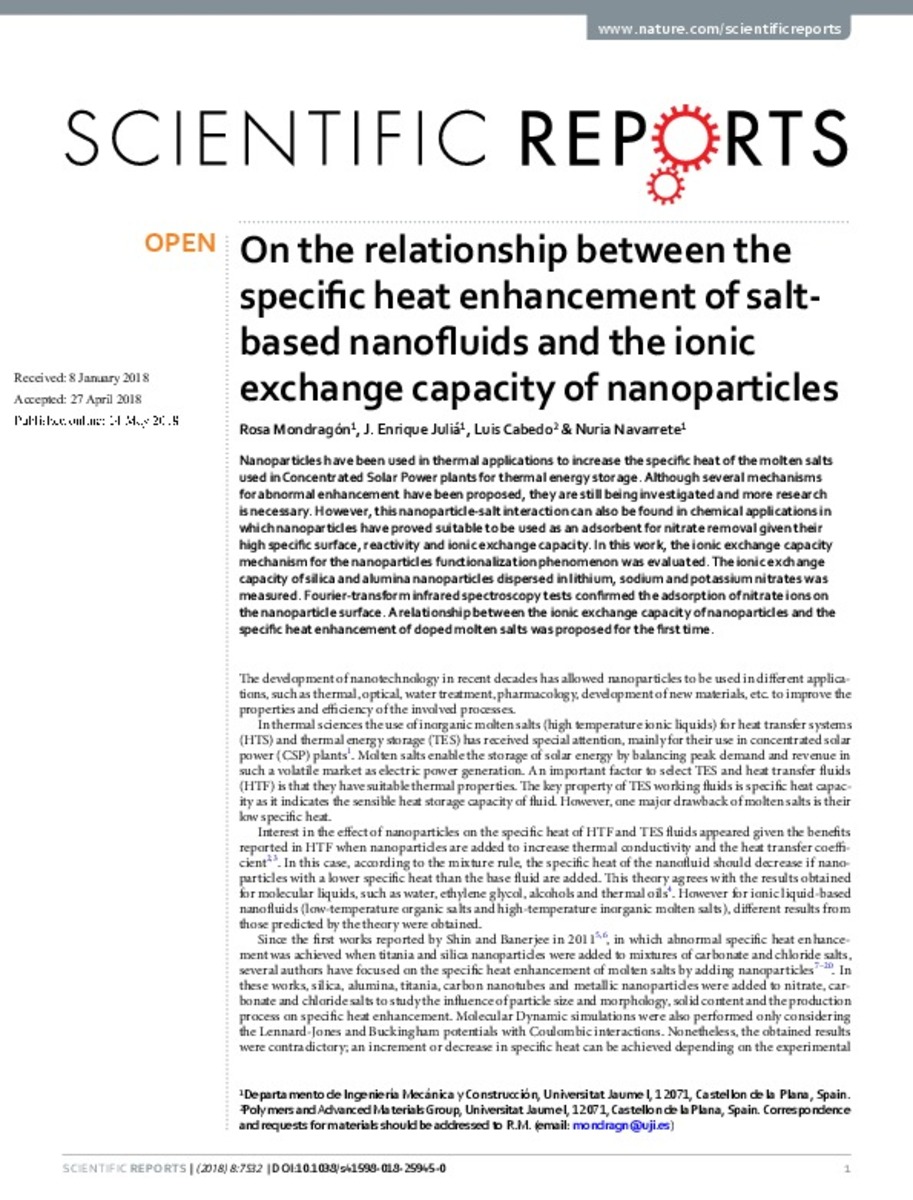Mostrar el registro sencillo del ítem
On the relationship between the specific heat enhancement of salt-based nanofluids and the ionic exchange capacity of nanoparticles
| dc.contributor.author | Mondragon, Rosa | |
| dc.contributor.author | Juliá Bolívar, José Enrique | |
| dc.contributor.author | Cabedo, Luis | |
| dc.contributor.author | Navarrete Argilés, Nuria | |
| dc.date.accessioned | 2018-06-12T18:04:18Z | |
| dc.date.available | 2018-06-12T18:04:18Z | |
| dc.date.issued | 2018 | |
| dc.identifier.citation | MONDRAGÓN, Rosa, et al. On the relationship between the specific heat enhancement of salt-based nanofluids and the ionic exchange capacity of nanoparticles. Scientific reports, 2018, 8.1: 7532 | ca_CA |
| dc.identifier.issn | 2045-2322 | |
| dc.identifier.uri | http://hdl.handle.net/10234/175121 | |
| dc.description.abstract | Nanoparticles have been used in thermal applications to increase the specific heat of the molten salts used in Concentrated Solar Power plants for thermal energy storage. Although several mechanisms for abnormal enhancement have been proposed, they are still being investigated and more research is necessary. However, this nanoparticle-salt interaction can also be found in chemical applications in which nanoparticles have proved suitable to be used as an adsorbent for nitrate removal given their high specific surface, reactivity and ionic exchange capacity. In this work, the ionic exchange capacity mechanism for the nanoparticles functionalization phenomenon was evaluated. The ionic exchange capacity of silica and alumina nanoparticles dispersed in lithium, sodium and potassium nitrates was measured. Fourier-transform infrared spectroscopy tests confirmed the adsorption of nitrate ions on the nanoparticle surface. A relationship between the ionic exchange capacity of nanoparticles and the specific heat enhancement of doped molten salts was proposed for the first time. | ca_CA |
| dc.format.extent | 12 p. | ca_CA |
| dc.format.mimetype | application/pdf | ca_CA |
| dc.language.iso | eng | ca_CA |
| dc.publisher | Nature Publishing Group | ca_CA |
| dc.relation.isPartOf | Scientific reports, 2018, 8.1: 7532 | ca_CA |
| dc.rights | © The Author(s) 2018 Open Access This article is licensed under a Creative Commons Attribution 4.0 International License, which permits use, sharing, adaptation, distribution and reproduction in any medium or format, as long as you give appropriate credit to the original author(s) and the source, provide a link to the Creative Commons license, and indicate if changes were made. The images or other third party material in this article are included in the article’s Creative Commons license, unless indicated otherwise in a credit line to the material. If material is not included in the article’s Creative Commons license and your intended use is not permitted by statutory regulation or exceeds the permitted use, you will need to obtain permission directly from the copyright holder. | ca_CA |
| dc.rights | Atribución 4.0 Internacional | * |
| dc.rights.uri | http://creativecommons.org/licenses/by-sa/4.0/ | * |
| dc.subject | energy storage | ca_CA |
| dc.subject | nanoscale materials | ca_CA |
| dc.title | On the relationship between the specific heat enhancement of salt-based nanofluids and the ionic exchange capacity of nanoparticles | ca_CA |
| dc.type | info:eu-repo/semantics/article | ca_CA |
| dc.identifier.doi | https://doi.org/10.1038/s41598-018-25945-0 | |
| dc.relation.projectID | This work has been partially funded by Universitat Jaume I through the project UJI-B2016-47 and Ministerio de Economía y Competitividad (MINECO) though the project ENE2016-77694-R. Nuria Navarrete thanks Universitat Jaume I for a pre-doctoral fellowship (FPI-UJI program) Ref. PREDOC/2016/28. Authors thank Servicios Centrales de Instrumentacion Científica (SCIC) of Universitat Jaume I for the use of DSC (Cristina Zahonero) and FTIR (Jose Miguel Pedra). | ca_CA |
| dc.rights.accessRights | info:eu-repo/semantics/openAccess | ca_CA |
| dc.relation.publisherVersion | https://www.nature.com/articles/s41598-018-25945-0#article-info | ca_CA |
| dc.type.version | info:eu-repo/semantics/publishedVersion | ca_CA |
Ficheros en el ítem
Este ítem aparece en la(s) siguiente(s) colección(ones)
-
ESID_Articles [463]
-
EMC_Articles [807]
Excepto si se señala otra cosa, la licencia del ítem se describe como: © The Author(s) 2018
Open Access This article is licensed under a Creative Commons Attribution 4.0 International License, which permits use, sharing, adaptation, distribution and reproduction in any medium or format, as long as you give appropriate credit to the original author(s) and the source, provide a link to the Creative Commons license, and indicate if changes were made. The images or other third party material in this article are included in the article’s Creative Commons license, unless indicated otherwise in a credit line to the material. If material is not included in the article’s Creative Commons license and your intended use is not permitted by statutory regulation or exceeds the permitted use, you will need to obtain permission directly from the copyright holder.








